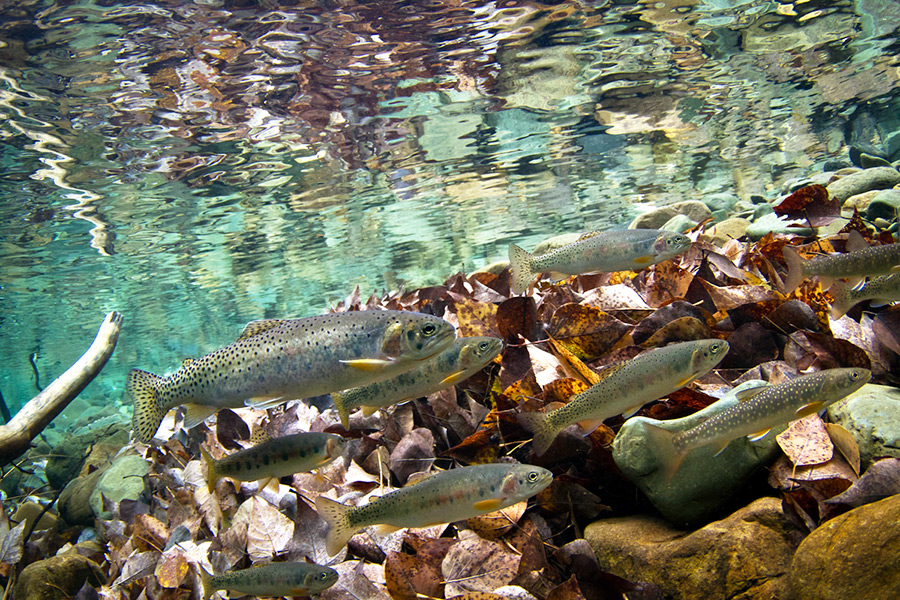Glacier Park Approves Native Trout Preservation Project
Fisheries managers to use rotenone to remove non-native fish, replace them with westslope cutthroat and bull trout
By Tristan Scott
Glacier National Park fisheries managers are moving forward with a conservation project aimed at restoring native westslope cutthroat trout and bull trout on a tributary of the North Fork Flathead River, where hybridization with nonnative fish has imperiled the prized species in a region considered their last best stronghold.
The project calls for stocking alpine lakes situated along the Upper Camas Creek drainage on the park’s west side, using genetically pure strains of the native trout species to create a baseline population from scratch. However, the architects of the project must first remove non-native Yellowstone cutthroat trout that have infested the drainage by using a fish toxicant called rotenone, which is extracted from the roots of several plant species in the legume family and is lethal to gill-breathing creatures. The lakes that park officials plan on treating include Lake Evangeline, Camas Lake and Camas Creek upstream of Arrow Lake in the park’s upper Camas drainage.
The National Park Service’s Intermountain Region approved the proposal June 10 after its director signed a Finding of No Significant Impact (FONSI) for the park’s “Westslope Cutthroat Trout and Bull Trout Preservation in the Upper Camas Drainage” environmental assessment. The FONSI is the final decision-making document for the project.
“The project is necessary to protect native westslope cutthroat trout against hybridization with non-native Yellowstone cutthroat trout, and to protect westslope cutthroat trout and bull trout against habitat degradation occurring because of a changing climate,” according to the environmental assessment.
In the United States, Glacier supports approximately one-third of the remaining bull trout populations inhabiting natural lakes. Bull trout are listed as a threatened species under the Endangered Species Act.
Westslope cutthroat trout and bull trout are essential to maintaining biodiversity throughout the Crown of the Continent ecosystem and are part of a historic fishery that is fundamental to Glacier’s designation as a biosphere reserve and World Heritage Site, the environmental assessment states, and they have long been integral to the culture of the park and surrounding communities.
Westslope cutthroat trout and bull trout are increasingly at risk, however, from the severe, negative effects of non-native fish, which were introduced to Glacier via fish stocking that began soon after the park was established in 1910, a practice that continued until the 1970s. Non-native fish have also migrated into park waters from lakes and streams outside the park.
Park officials anticipate the project to begin late this summer in cooperation with Montana Fish, Wildlife and Parks, the agency whose fisheries program was responsible for a similar project in the South Fork Flathead River drainage upstream of Hungry Horse Dam.
Native westslope cutthroats found in the Flathead River system and elsewhere are precious gems, each fish equipped with the genes and genetic wiring of its ancestors, traits developed specifically for certain drainages and long-term survival in a harsh northern Montana climate.
Westslope cutthroat trout have lived in post-glacial western Montana for thousands of years. During that time, the species has been able to survive catastrophic fires, massive floods and severe droughts.
Yet less than 10 percent of the species’ historic range still exists, and the fish is considered a state-listed “species of concern” in Montana and “threatened” in Alberta.
“The stressors to westslope cutthroat trout and bull trout from non-native fish are compounded by habitat changes that are occurring as a result of climate change, such as altered precipitation patterns, higher water temperatures, and damage to spawning beds from flood events,” according to the environmental assessment. “Changes in stream flow and increasing frequency and intensity of disturbances, such as wildfire and rain-on-snow events, also have the potential to impact native fish.”
The environmental assessment evaluated impacts to native fish and aquatic species, recommended wilderness and natural soundscapes, common loons and other water birds, grizzly bears, and visitor use and experience. No potential for significant adverse impacts was identified.
The EA was available for a 20-day public comment period beginning March 29, and public comments were considered.
“This project would not only advance native fish conservation in Glacier, but would also bolster ongoing efforts by Montana Fish, Wildlife and Parks, the U.S. Fish and Wildlife Service and the Flathead National Forest to conserve these important native species in the larger Flathead River ecosystem,” the environmental assessment states.